- This page contains pictures and information about Biology of Lacewings, Antlions and Owl Flies
in Order Neuroptera that
we found in the Brisbane area, Queensland, Australia.
-
 - The stalked Lacewing eggs
-
- Lacewings, Antlions and Owl Flies are insects belonged to the Order Neuroptera.
Adults in this insect order
have two pairs of transparent wings about the same size. Their wings are
large and membranous with complex vein pattern, although they are not very
good flier. Their bodies are long and soft. They have the biting and chewing
mouthparts. They are the predators on other insects. Their body size range
from very small 5mm to very large 150mm.
-
- The adults insects have two pairs of lace wings. They have two pairs of
large to very large eyes with cerci absent. When fly, they may be mistaken
as dragonflies. When rest,
their wings fold on their back as a tent-like shape which dragonflies never
do. They can also be distinguished by their pair of long to very long
antenna while dragonflies' are very short.
-
- During summer night time, they are sometimes attracted to houses by window
lights.
-
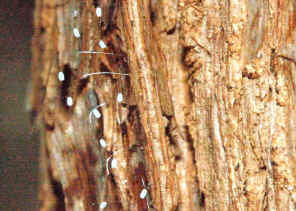 

-
- Lacewings develop in complete
metamorphosis, with egg, larvae, pupa and adult states. Most of them lay
eggs on leafs or stalks. Eggs are either in rows or in 'U' shaped arrangement.
Some species larvae are active predators while some are in parasites
forms. Larvae are 3-5 instars stages.
-
 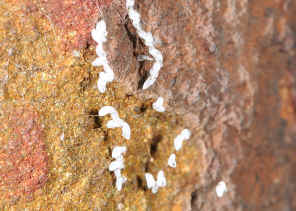

-
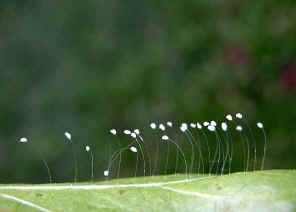

 - The stalked eggs
Larva just hatched Photo
thank to Peter
Martin
-
- Females lay eggs in group. The above pictures show two typical types of
Lacewings eggs. Notice that the eggs are laid on thin sticks. Lacewing
larvae are active predators. Most of them have long mandibles. Eggs laid on
thin sticks is believed that it helps to prevent cannibalism. Larvae pupate
in a loose cocoon make of silk and usually attached with sand or other
materials.
 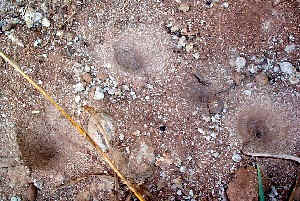

-
- The famous Antlions are in this order.
Antlion is the common name given to the larvae of those insects. The larvae build sand traps
to trap the ants walk by. Above 3rd picture shows the struggling ant in a sand trap.
-



-
- Larvae in other species are predators hunting on stems and on leaves. They
have very long mandibles. Some of them may be covered with prey body or other
plant litters on body.
-
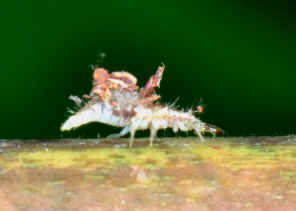


-
- We found the above Lacewings Larvae hunting the aphids in our
backyard in spring. The next picture shows the Lacewing eggs that we found near
by.
-
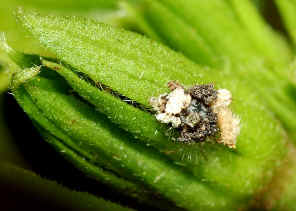

 -
 
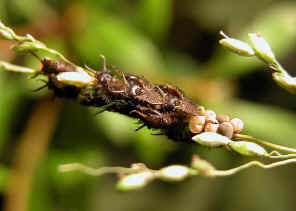
-
- Their eggs are hard and oval, laid in masses around twigs or grass-stalk,
number in about 50 to 100.
-
-

-
- Reference:
- 1. Insects
of Australia, CSIRO, Division of Entomology, Melbourne University
Press, 2nd Edition 1991, pp 525.
- 2. Lacewings
- by Charlma Phillips, Forest Health Scientist, Forest Insects, ForestrySA,
1993.
- 3. Order NEUROPTERA, Ant-lions, Lacewings - Australian Faunal Directory, Australian Biological Resources Study.
- 4. A revision of the Australian Mantispidae
(Insecta : Neuroptera) with a contribution to the classification of the family. I. General and Drepanicinae - KJ Lambkin, Australian Journal of Zoology Supplementary Series 34(116) 1 - 142,
1986.
- 5. A revision of the Australian Mantispidae
(Insecta : Neuroptera) with a contribution to the classification of the family. II.* Calomantispinae and Mantispinae - KJ Lambkin, Australian Journal of Zoology Supplementary Series 34(117) 1 - 113,
1986.
- 6. Northern
Territory Insects, A Comprehensive Guide CD - Graham Brown, 2009.
[ Home ] [ Lacewings, Antlions and Owl Flies Biology ] [ Osmylidae ] [ Mantispidae ] [ Hemerobiidae ] [ Chrysopidae ] [ Nymphidae ] [ Myrmeleontinae ] [ Stilbopteryginae ] [ Ascalaphidae ]
|